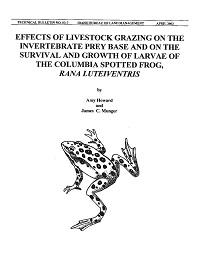Effects of Livestock Grazing on the Invertebrate Prey Base and on the Survival and Growth of Larvae of the Columbia Spotted Frog, Rana Luteiventris

This report discusses results primarily from the second of two field seasons in which two aspects of grazing were examined for possible effects on Columbia spotted frogs (Rana luteiventris). First, exclosures were used to prevent grazing on portions of the streams and ponds to ascertain the effects of grazing on the invertebrate prey base utilized by the frogs. Although we found no statistically significant effect of grazing on either biomass or diversity of invertebrate prey, care must be taken in the interpretation of these results. While it is possible that there was no effect of the specific grazing regimes of these sites on the invertebrate community, the small sample size, the very general taxonomic identification used, and weaknesses in study design may have masked any true differences. Adult spotted frogs were apparently not actively feeding during late August to late September. Metamorphs and subadults, however, would need to forage at that time to accumulate necessary fat reserves and would therefore be affected by changes in the invertebrate community. Further work is needed to more solidly document the effects of grazing on invertebrates.
